|
Monumental three canister rosewood tea chest with mother of
pearl inlay Circa 1830
Please click on images to enlarge or |
slide show |thumbnail index |
Reference: TC566
Description:
TC566: Monumental three canister tea chest in figured rosewood
on a mahogany carcass with mother of pearl inlay standing on turned
rosewood feet having turned rosewood drop ring handles.
The shape of this chest combines elements and influences
characteristic of the early nineteenth century. It is structured in an
ancient Egyptian architectural form combining tapered and pyramid
lines which make this caddy a strong statement of the robust and elegant
style of the Regency. The composition of the top is strong. The inlaid
mother of pearl inlay panels are set off by a further stringing of
white metal (pewter). circa 1830.
Origin: UK possibly
Scotland Circa: 1830 Materials: rosewood, mahogany, mother of
pearl.
Size: It measures 14 inches
wide by 10.5 inches deep and it is 8.1 inches high
including feet: 35.5 cm wide by 26.7 cm deep by 20.6 cm high.
Condition: good
overall, working lock and key, see images.
As each person has different criteria and antiques by their very nature
have wear please enlarge the images and ask for extra information
as needed.
|
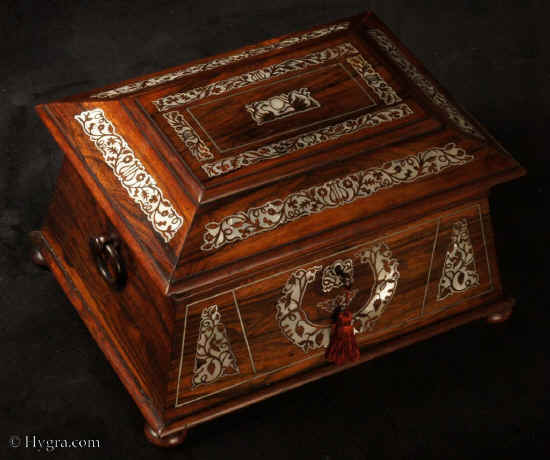
The quality of materials and craftsmanship
are exceptional.
|

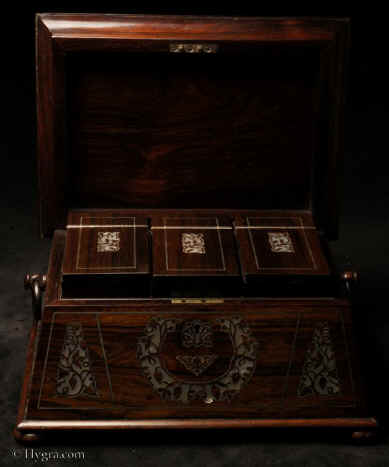
|
The chest has clearly been looked after carefully and has survived
with its original polish which shows gentle patination.
Inside there are three lift out canisters with hinged lids. Their
tops are inlaid with mother of pearl.
The chest is unusual in that it is extra deep front to back and
has three tea canisters and no sugar bowl. Perhaps the original
owner had three favourite types of tea, or perhaps he wanted to
make a point of not taking sugar. Sugar, which at the time was produced
using slave labour was beginning to be shunned by some people of
principle.
|
Please click on images to enlarge or |
slide show |thumbnail index | Request
current list of available tea
caddies.
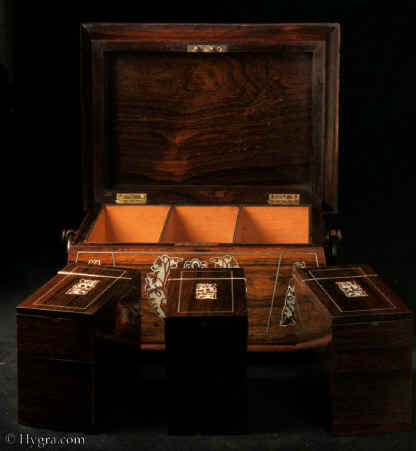
|
The interior bottom part of the caddy is lined in mahogany which is
edged in rosewood.
The construction quality is exceptional. The canisters are crafted in
stable quarter sawn mahogany and veneered with thick rosewood
veneers.
|
The canister hinges are specially made from thin brass sheet.
|
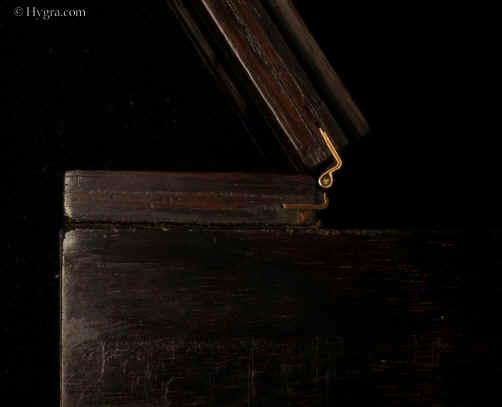
|
Please click on images to enlarge
The inside of the canisters still retain traces of their
original leading.
|

|

|
The hinge of one of the canisters is damaged. Restoration
would involve making a new matching hinge. It would be unacceptable for
any wood to be cut away because an almost right hinge was available.
|
Please click on images to enlarge or |
slide show |thumbnail index | Request
current list of available tea
caddies.
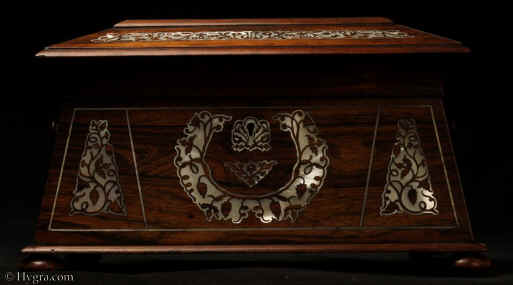
|
The inlay of vines is unusual. Although there is a naturalistic
looping and trailing element, the arrangement still adheres to the
symmetry of neoclassicism. The escutcheon is an ingenious interpretation
of a palmette made up of stylised flora.
The two flanking inlays suggest temple columns narrowing as they
disappear higher up the line of vision.
The maker uses perspective to suggest the gravitas of monumentality.
|
The caddy has a working lock and key.
The strong figuring of the rosewood is clearly visible.
The inlay is beautiful in its trailing grace combined with controlled
symmetry. The lyre in the centre provides a neoclassical punctuation
point to the floral theme.
The central design of the two swans provides a controlled but
asymmetrical note of whimsy.
Although adhering to neoclassical rules, the chest gives the
impression of energy with its lively inlay and vigorous figure.
|
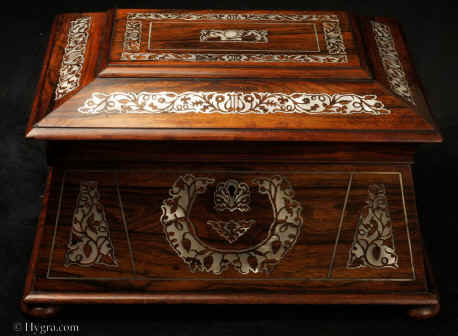
|
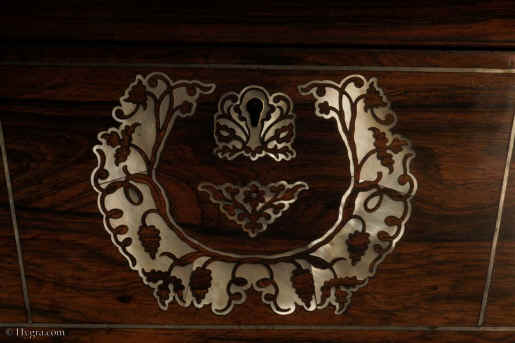
|
Detail: the symmetry would have been hard to achieve. the outside
depicting a trailing vine needed five separate pieces of mother of
pearl. The sawing had to be done by hand. using soap as a lubricant.
Mother of pearl is brittle and would have needed a very steady
hand.. The thin blades would break if the worker craftsman
had even hesitated in his stroke.
|
Please click on images to enlarge or |
slide show |thumbnail index | Request
current list of available tea
caddies.
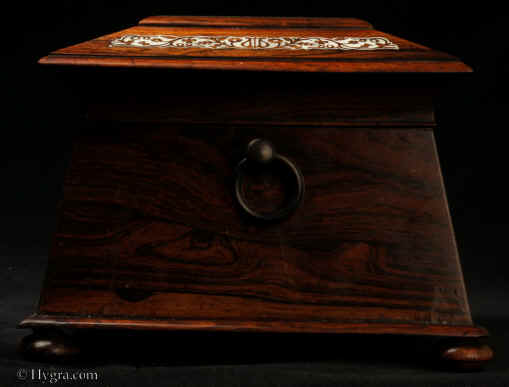
|
Side view showing the beautiful figure and the lines of the complex
structure.
|
Back view. The strong figure on a large area shows to advantage.
|
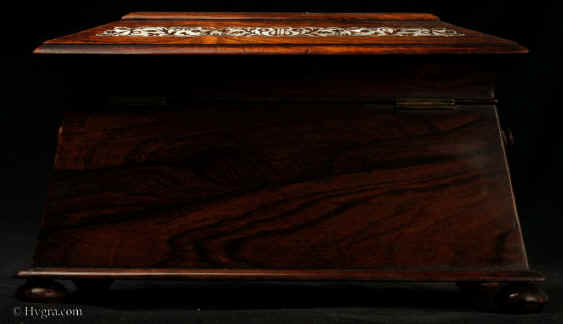
|
Other side.
|
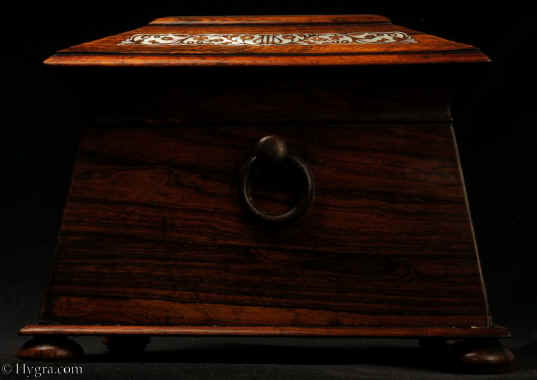
|
Please click on images to enlarge or |
slide show |thumbnail index | Request
current list of available tea
caddies.

|
The angle showing the clever use of the narrowing and then widening
of the lines of the chest to achieve its striking form..
|
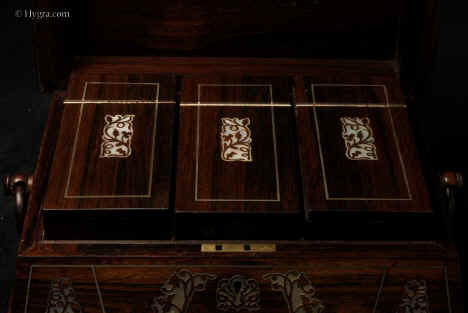
|
The chest open with the canisters in place.
|
Please click on images to enlarge
The caddy has a working lock and key.
The lock plate is stamped with a crown and the word
"patent".
The use of the word patent does not mean that the lock maker was an
innovator.
The patent being referred to was the use of a lever dated to the 18th C
and would have expired.
|
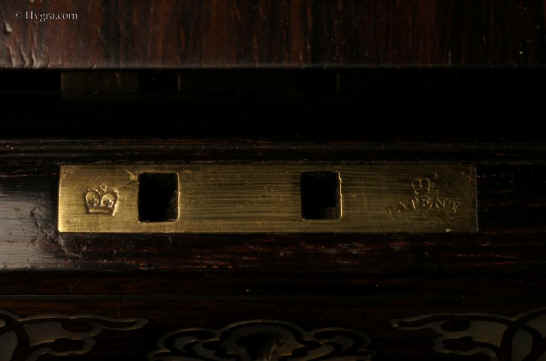
|
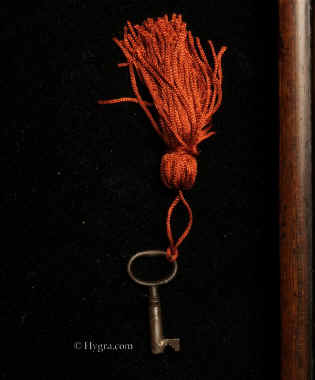
|
The key.
|
Please click on images to enlarge or |
slide show |thumbnail index | Request
current list of available tea
caddies.
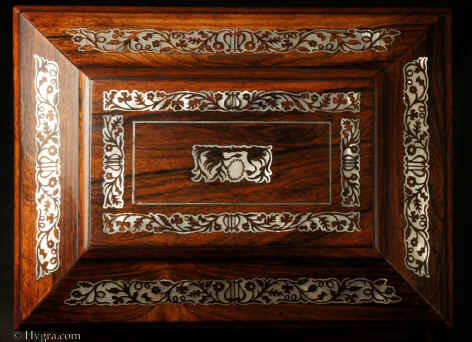
|
The composition of the top is strong. The inlaid
mother of pearl inlay panels are set off by a further stringing of
white-metal. (pewter).
The Top has a central finely inlaid panel of rosewood framed by a
solid rosewood molding and fielded by further panels of inlaid rosewood.
The symbolism of the inlay design seems to be of an
united Britain: the Thistle for Scotland, the shamrock for
Ireland.
|
The central panel of inlay is a work of art in itself and would have
taken many hours to make.
It seems to have been made with a piercing saw. The saw marks are
just visible. The thin lines cut into the rosewood indicate the use a
very fine blade used with fantastic control.
|

|
Please click on images to enlarge or |
slide show |thumbnail index | Request
current list of available tea
caddies.
Please click on images to enlarge
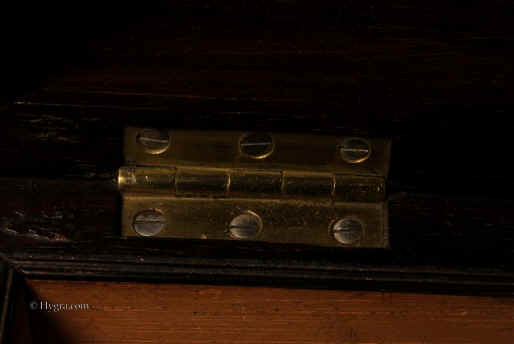
|
The slots of the steel screws have been lined up.
The compartment for holding the canister is lined with mahogany edged
with rosewood..
The attention to detail is phenomenal.
|
Please click on images to enlarge or |
slide show |thumbnail index | Request
current list of available tea
caddies.
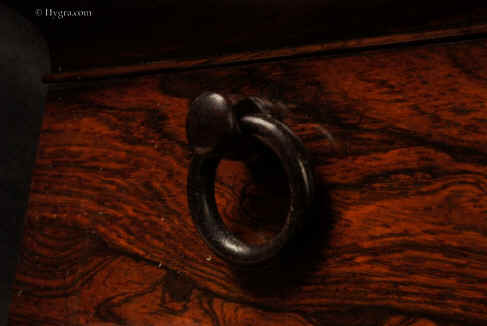
|
The caddy has turned rosewood drop handles.
|
Please click on images to enlarge
Please click on images to enlarge
|
slide show |
thumbnail index |Request
current list of available tea
caddies.
All text and images and linked images are ©
1999-2011 Antigone Clarke and Joseph O'Kelly. If you require any further
information on permitted use, or a licence to republish any material, email us
at copyright@hygra.com
|